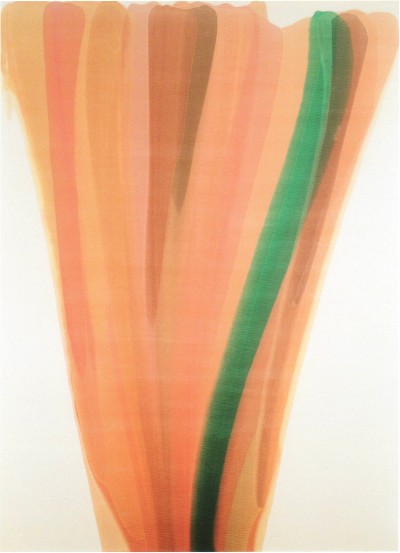So Bleats the Nuclear Platypus
May 22nd, 2008
Three images from the second edition (2008) of the Nuclear Platypus Biscuit Bible by Pope Gus (see previous post for first edition imagery).

The God-Biscuit (p102).
The new edition sports expanded cantos, several new appendices, and satisfyingly addresses a number of long-standing erratum. In the latter camp, for example, the humanoid used-car salesman facade of Xe8eX’s Presidential disguise is properly named Shaquille O’Neal (p23); and the strange species of creature post-dating the dinosaurs is correctly designated hornulus (p60), rather than dorkosaurus, reflecting recent evidence that these critters were more horny than dorky.
And Pope Gus finally makes good on the foreshadowing in the Gospel of Quxxxzxxx in which it states of the Oozumgreep, “What it would be we could not yet tell, but whatever it was involved propellers and an unconscionable amount of rayon” (p52). As we now know, these are the creatures that, thousands of years later, would propel[ler] the BisQuitus-era UFOs that ferried “I” away from the end times. (For bonus points, compare and contrast the updated UFO manifest.)

Only a careful reading, however, reveals the subtle revisions that evidence the confidence and vision of Pope Gus’s spiritual progress over the nearly two decade hiatus between editions. Perhaps none more so than his reshuffling of the six billion year old Twelve Commandments of the God Biscuit.
Consider, in particular, the original seventh commandment, “I exist only to amuse myself,” and the now tenth commandment, “I and thou exist only to amuse Myself” — an explicit nod to the esoteric teachings of the God Biscuit (“As above, so below”) that remain hidden to the mass of mainstream Arglebargleists. The three-step delta is a clue so formidable I will not call attention to it.
Percipient numerologists will also observe the updated icon of the Nuclear Platypus Himself. For where His Gesture was before a four-sided, four-dimensional “quadrilateral tesseract”, obviously representing the visible Work, the new Gesture goes one hermetic step further, symbolizing the five-sided objective of Perfected Man: “The Platypus most Nuclear had in His right hand something that was neither a noun nor a verb, and in His left hand He gently caressed an aperiodic pentagonal tessellation” (p102).

Sasquatchi hierogyphics (p77).
By now you should have a sense of the significance of this second edition. Therefore, let us rather turn our gaze obversely, to this bonus image, lifted from an Arglebargle brochure, recovered from the Unurthed Vault, so archived there circa 1991:

Morris Louis and Negation
May 17th, 2008
Three paintings by Morris Louis, reproduced with commentary in Morris Louis Now.

Beth Chaf, 1959, cat. 10.
“Lucy Lippard wrote in 1965 that Louis was a ‘meditative action painter,’ and there is something in that oxymoronic phrase — a thoughtful, deliberate expressionist — that captures this view of Louis as the painter of disinterested displays of emotion: feeling, yes, but always subject to elaborate rules” (p22).

Dalet Tet, 1959, cat. 11.
Says Louis, “Am distrustful of over simplifications but nonetheless think that there is nothing very new in any period of art: what is true is that it is only something new for the painter & that this thin edge is what matters. I suspect it is possible to relate every bit of abs. exp. to other art in a breakdown. It comes out new & different when art history is submerged and making a painting is a simple experience not precisely like any the artist had before… I don’t care a great deal for positive accomplishments… that leads to an end… I look at paintings from the negative side, what is left out is useful only as that leads to the next try and the next” (p45).
Alpha Tau, 1960-61, cat. 21, click for larger version.
“To use one of Fried’s favorite words, the only ‘perspicacious’ thing about [Louis’s Unfurleds] is their slight of hand: perception is made oddly criminal, perverse, or underhanded because it is pushed to grasp color quickly on the margins. One looks at these huge works in complete bafflement. I am tempted to say that negation is not experienced here but read. But this is not the case. Faced with the overwhelming presence of negation, front and center, it is color that is read or that does the narrating. Confronted by the monumental chiasm of Alpha Tau, for example, it is as if one can steal only furtive glances of the ribbons that are spread or pushed to the sides. Looking directly at these ribbons renders them devoid of meaning or sense: they exist as inconsequential details in comparison with the expanse of blank canvas. One feels insincere or disingenuous to the painter’s intention when one does focus on the ribbons. One knows that in focusing on either end one is blinding oneself to the position that color occupies within the whole. Color is best served here when buried in a uniquely metonymic grave, not only within and beyond negation but distinctly beside or just past it” (p53).
